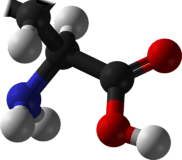Dehydroamino acid

Dehydroalanine is the most common dehydroamino acid. Notice that it is not chiral.
In biochemistry, a dehydroamino acid is an amino acids with a C=C double bond in its side chain. Dehydroamino acids are not coded by DNA, but arise via post-transcriptional modification. The most common examples are dehydroalanine and dehydrobutyrine, derived from dehydration of serine/cysteine and threonine, respectively.
Generally, amino acid residues are unreactive toward nucleophiles, but the dehydroamino acids are exceptions to this pattern. For example, dehydroalanine adds cysteine and lysine to form covalent crosslinks.[1]

References
- ↑ Dawid Siodłak "α,β-Dehydroamino Acids in Naturally Occurring Peptides" Amino Acids 2015, vol. 47, pp. 1–17. doi:10.1007/s00726-014-1846-4.
This article is issued from Wikipedia - version of the 3/20/2016. The text is available under the Creative Commons Attribution/Share Alike but additional terms may apply for the media files.
